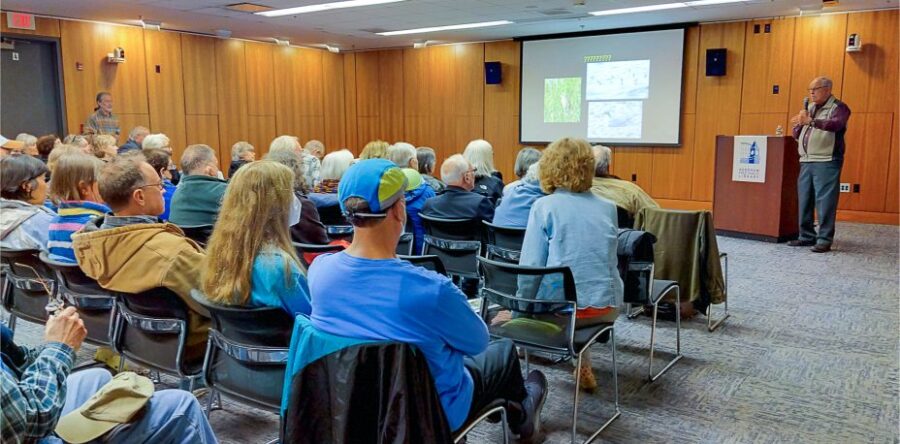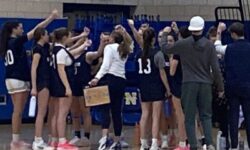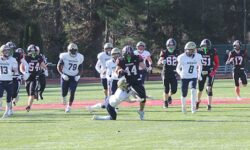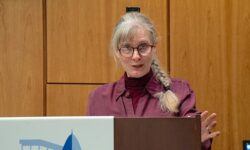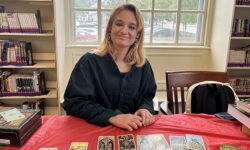By Audrey Anderson
Hometown Weekly Report
Wayne R. Peterson, the former Director of the Massachusetts Important Bird Areas (IBA) Program at Mass Audubon, spoke at the Needham Free Public Library about how the bird species resident in Massachusetts have changed over time. The changes he described were due to actions and decisions by humans as well as the effects of climate change.
As Petersen explained, when the first Europeans came to the Massachusetts area in 1620, they found old-growth forest, with tall trees growing densely together. At that time, the common species were the birds that live in forests, such as the pileated woodpecker, eastern goshawk, and barred owl.
As soon as the Europeans arrived, they began to cut trees, eventually removing almost all of them for their “small farms, lumber, ship building, and ship’s masts.” By the 1830s, much of southern Massachusetts was clear cut. The forest bird’s numbers were decreasing. By the 1850s, turkeys and common ravens were extirpated from the area.
In the newly cleared landscape, while populations of forest birds declined, open country or grassland birds from the Midwest began to inhabit the area. Soon bobolinks, vesper sparrows, and upland sandpipers were common. A prairie bird, the brown cow bird, laid its eggs in other birds’ nests and eventually crowded out the eggs of the other birds, wiping out the other species.
When people moved from the open land in Massachusetts to cities and to the West in the late nineteenth century, “forest succession” followed, which is the regrowth of the forest on abandoned lands. The eastern towhee, brown thrasher, and other shrub birds became the dominant species.
At the turn of the 20th century, ducks, geese, and other waterfowl were increasingly shot for food and for sport. It became fashionable for women to wear the feathers of long-legged wading birds and tropical birds on their hats to decorate their homes.
Gradually, women such as Harriet and her cousin Minna Hall spoke out about the harm being done to waterfowl in the name of fashion. Together with William Brewster, they helped to establish the Massachusetts Audubon Society in 1896 to make an impact on “conservation, legislation, and education.” Harvard ornithologist encourage people to study bird with binoculars and their eyes, rather than killing them to study them.
During World War II, many birding areas could not be used due to military restrictions, and optical equipment used in birding, such as binoculars and cameras, was not available. In the 1950s and 1960s, with troops home from the war and equipment becoming more available, birding became popular. Bird clubs, bus trips, and campouts were organized. Numerous journals and field guides were published.
In the 1970s, the widespread use of pesticides like DDT led to the eradication of bald eagles, ospreys, and peregrine falcons in Massachusetts. The poisons led to eggshell thinning and the inability to lay healthy eggs. At the same time, wetlands were drained and used for dumping trash. The populations of birds such as American bitterns and sorrels declined.
Due to an interest in waterfowl hunting, wetlands were revived in the 1980s and 1990s. Due to the declining use of DDT, bald eagle, osprey, and peregrine falcon populations returned to the area. Through his survey of Massachusetts history, Petersen demonstrated that the actions of mankind had influenced bird species that were present in Massachusetts.
In the new era of climate change, other changes may happen, such as more southern birds relocating to the area and northern species declining. Rising seas levels may lead to the destruction of salt marshes and their resident birds.
In answer to an attendee’s question about what he could do in Needham to help bird populations stay healthy, Petersen suggested that people avoid using pesticides and rodenticides, plant native species in their gardens, drink “bird-safe” coffee grown in shady areas, use feeders, erect bird houses, and provide baths.



